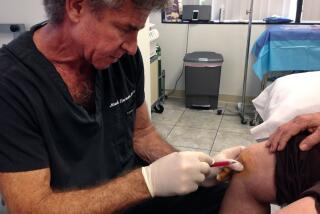Mix of Stem Cells With Mouse Cells Is Obstacle
- Share via
WASHINGTON — Most or all of the human embryonic stem cell colonies approved for research funding under a new Bush administration policy have been mixed in the laboratory with mouse cells, possibly creating substantial hurdles for scientists trying to turn the colonies into treatments for Parkinson’s disease, spinal cord injuries and other ailments.
The cell colonies, or “lines,” were originally created for early-stage research with no thought that they would become the only embryonic cells eligible for federal money. But that’s the status President Bush gave them Aug. 9.
The standard technique for creating human embryonic stem cell lines has been to extract cells from inside a microscopic embryo, then grow them atop embryonic mouse cells, known as “feeder” cells. The latter excrete some unknown nutritional or growth factor that helps the human cells stay healthy. Because they’ve been in close contact with mouse cells, the human cells pose a small but real risk of transferring potentially deadly animal viruses into people.
Because of that, under guidelines the Food and Drug Administration has been developing for several years, it would be difficult, though not impossible, to use the cells in human clinical tests.
Under the FDA rules, which are designed to prevent the accidental creation of a new plague, transplants of these embryonic cells into people would be treated as though they were “xenotransplants,” or transplants of animal tissue. The guidelines impose stringent requirements on researchers and patients alike. They would probably rule out some groups of patients who might otherwise be eligible to participate in human stem cell tests--notably patients whose disease can be treated in other ways.
The human embryonic stem cell lines reported in scientific literature were all grown in direct contact with mouse cells and might have picked up mouse viruses, bringing them, government officials acknowledged, under the FDA policy.
Scientists are working on ways to grow human embryonic cell lines without using mouse cells, but those created since Aug. 9 would be ineligible for U.S. research money.
Patient groups and people who work with them expressed concern when told about the xenotransplant restrictions.
“This would be the exclamation point” on an already lengthy list of questions about the quantity and quality of the cell lines eligible for research funding, said Kevin Ryder, a consultant to the American Cell Therapy Research Foundation, a New York foundation that supports research into treatments using cells.
Concern was also voiced on Capitol Hill. “The president’s going to have to make available lines of stem cells that will be available for the full measure of research anticipated,” said Sen. John F. Kerry (D-Mass.). “If he doesn’t, Congress will need to act to make that happen.”
Jay Lefkowitz, a White House advisor who helped craft the Bush policy, said the administration knew of the mixing but concluded that the issue wouldn’t be a serious barrier at this stage.






